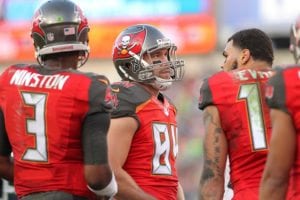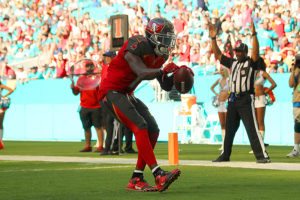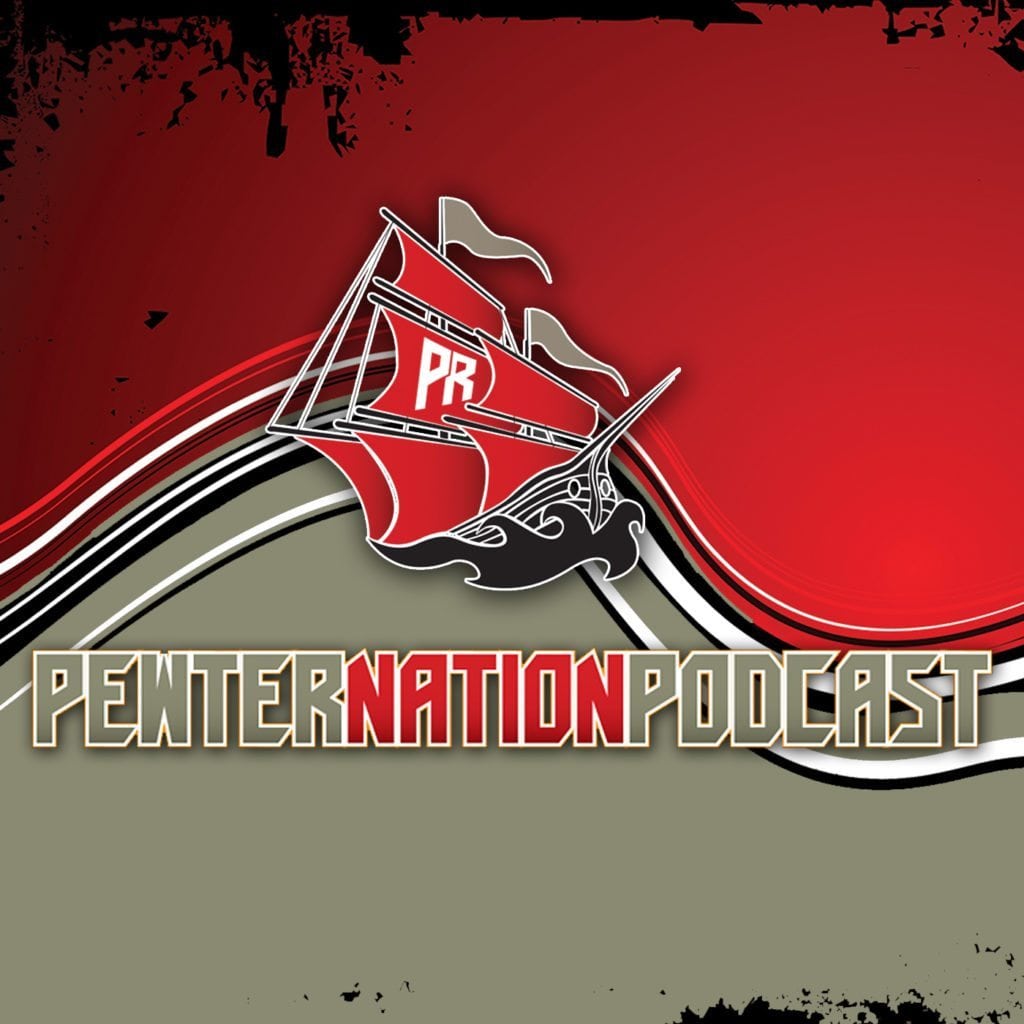Table of Contents
FAB 3. Bucs’ Red Zone Data Dive
To underscore how important red zone touchdown production to the success of an NFL team, it’s important to note that the No. 2 red zone touchdown team in 2017 is Philadelphia, one of Sunday’s Super Bowl participants, with a 65 percent touchdown rate. New England, the other team in the Super Bowl, is third in red zone touchdown production with a 63.29 percentage.
Who was the No. 1 team in the league in red zone touchdown percentage last year? Jacksonville, which was one of the NFL’s final four playoff teams, had a league-best 68.97 red zone touchdown percentage.
So why are the Patriots back in the Super Bowl again this year? Because New England had a 64 percent TD rate in the red zone in 2016 that was nearly identical to this year’s rate of 63.29.
Why did Atlanta make it to the Super Bowl last year, but not this year? The Falcons’ red zone touchdown percentage was 64.56 percent in 2016, but fell to 49.18 percent this year.

Bucs QB Jameis Winston and WR Mike Evans – Photo by: Getty Images
Tampa Bay was also a better red zone team in 2016 with a 51.85 percentage. This year, the Bucs’ red zone touchdown percentage fell slightly to 49.06, which ranked 24th in the NFL. If offensive coordinator Todd Monken and head coach and play-caller Dirk Koetter can fix the Bucs’ red zone woes and get that touchdown percentage up to 60 percent or better, Tampa Bay could be playoff bound in 2018.
The Bucs only had eight rushing touchdowns last year, which ranked tied for 25th in the league, and all of them came in the red zone. Tampa Bay had 18 passing touchdowns in the red zone in 2017 – two less than the previous year – but who produced them was quite different than the 2016 season.
Let’s break down the Bucs’ red zone targets in each of the past two seasons and draw some conclusions that can help the team moving forward in 2018.
Wide receiver Mike Evans tied his team record with 12 touchdown catches in 2016 with seven of those scores coming in the red zone. The 6-foot-5, 230-pound Evans was the most targeted Buccaneer in the red zone that season with 19 passes going his way and nine of them resulting in catches for 77 yards and seven touchdowns. Evans had a 47.37 percent red zone catch rate.
Evans was even deadlier inside the 10-yard line in 2016 where nine of his 19 targets occurred. Of those nine targets, Evans caught six passes for 32 yards and every catch resulted in a touchdown and a 66.67 percent catch percentage inside the 10-yard line.
But the 2017 campaign was a totally different story. Evans again had 19 red zone targets, but only caught five of those passes for 46 yards and three touchdowns, which computes to a 26.32 percent catch rate. Despite his size, Evans was even worse inside the 10-yard line, where he was targeted nine times, but had only one catch for six yards and a touchdown. His catch rate on targets inside the 10-yard line was just 11.11 percent.

Bucs QB Jameis Winston, TE Cam Brate and WR Mike Evans – Photo by: Cliff Welch/PR
Hindsight shows that Evans probably shouldn’t have gotten as many targets as he did because he was either well covered, which resulted in so many incompletions, or there was a disconnect between he and quarterbacks Jameis Winston and Ryan Fitzpatrick. In 2017, Winston was just 5-of-13 (38.5 percent) for 46 yards with three touchdowns when targeting Evans in the red zone. Winston connected with Evans for a 13-yard TD in the Bears game, a 12-yard scoring strike in the Bills game and a 6-yard touchdown in the Giants game, but had 14 incompletions on passes thrown to Evans in the red zone in eight other games.
So if the Bucs’ top red zone weapon wasn’t Evans, it was tight end Cameron Brate, right? In 2016, Brate was targeted inside the 20-yard line 17 times and had 11 catches for 79 yards and eight touchdowns for a 64.71 percent catch rate. Brate was even deadlier inside the 10-yard line a year ago, with seven catches out of nine targets for 34 yards and six touchdowns and a 77.78 percent red zone catch rate.
Last year, defenses did a better job accounting for Brate in the red zone. He was targeted 13 times, but only produced five catches for 68 yards with each catch going for a touchdown and a 38.46 percent catch rate. But inside the 10-yard line, Brate was only targeted four times and had one catch for 10 yards, which was a touchdown, and a 25 percent catch rate.
In 2016, Evans and Brate were targeted a combined 36 times and produced 15 touchdowns. Last year, that duo was targeted 32 times and produced only eight TDs.
So Monken and Koetter need to either find ways to make Evans and Brate better in the red zone and more efficient like they were in 2016, or understand that those two are going to receive most of the attention in red zone and design more plays for the ball to go elsewhere. Not including wide receiver Bobo Wilson, former tight end Luke Stocker and offensive tackle Leonard Wester, who each had one red zone catch for a touchdown last season, there were three other weapons that shined inside the opponents’ 20-yard line.

Bucs WR DeSean Jackson – Photo by: Cliff Welch/PR
Rookie tight end O.J. Howard was targeted six times in the red zone and had four catches for 32 yards and three touchdowns for a 66.67 catch rate. The 6-foot-6, 255-pound Howard was even better inside the 10-yard line where four of his six targets occurred and he caught three passes for 15 yards with each reception going for a touchdown and a 75 percent catch rate.
Newly added wide receiver DeSean Jackson was incredibly efficient with four catches for 18 yards and two touchdowns on six targets for a 66.67 percent catch rate. The shifty Jackson was perfect inside the 10-yard line, catching both of his targets for eight yards and two touchdowns and a 100 percent catch rate.
Wide receiver Adam Humphries doesn’t have Jackson’s speed, but he’s proven to be elusive in the red zone, too. Last year, Humphries caught all five of his targets for 39 yards and a touchdown for a 100 percent catch rate. Humphries wasn’t targeted inside the 10-yard line, but perhaps he should have been given his catch percentage.
Running back Charles Sims was the other recipient of a red zone touchdown, which came inside the 10-yard line on his only target. Sims was targeted six times in the red zone, catching three passes for 21 yards, but may not be back as he’s an unrestricted free agent.
In their quest for improved red zone touchdown efficiency, Monken and Koetter must find a way to get Evans and Brate back to their old ways of dominating in the red zone or continue to make the Bucs’ other weapons more productive if Evans and Brate are going to continue to draw double coverage in or near the end zone. As Monken noted earlier, the best red zone teams run the ball, so revamping Tampa Bay’s ground game is also on the to-do list to increase touchdown production in 2018.


